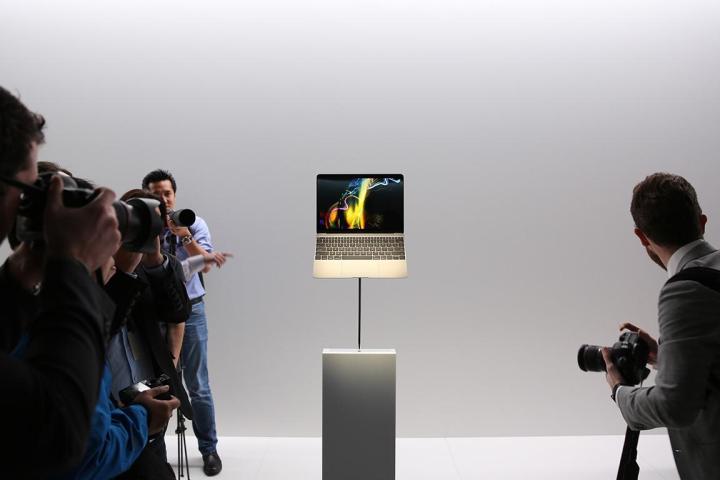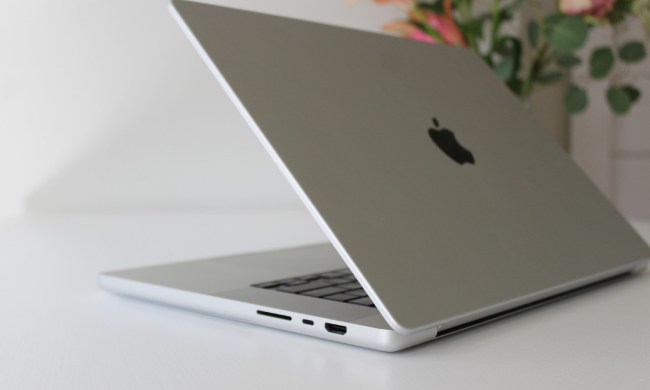
As with all cutting-edge hardware, though, the system has its fair share of flaws and frustrations. Near universal love of the MacBook’s display, touchpad and display is balanced by criticism of the single USB port and the keyboard, which is much slimmer and offers less key travel than used in the past. Here’s a summary of what reviewers around the web had to say.
Design
Predictably, the MacBook’s look and feel has been met with almost universal praise. Andrew Cunningham of Ars Technica noted that it fits perfectly into Apple’s current design language, and that “One could almost be forgiven for thinking the new MacBook was an iPad Air 2 connected to a keyboard dock.”

Size and weight also impressed. Dana Wollman, writing for Engadget, said “this new machine is markedly skinnier than any other MacBook you’ve seen: just 13.1mm (0.52 inch) at its thickest, tapering down to a razor-thin 3.5mm (0.14 inch) — about as thick as a stack of four credit cards.” Multiple reviewers stated the 12-inch display seems like a good compromise between the 11-inch Air, which was too small for many users, and the 13-inch Air, which is now a bit larger than it needs to be for its display size.
Connectivity
Apple’s decision to go with a single USB Type-C port was almost universally criticized, with many reviewers doing their best not to come off as one-note in their disapproval. Ars Technica and The Wall Street Journal seem the most disappointed. Joanna Stern, writing for the latter, says bluntly that “the MacBook’s real annoyances begin with that single USB Type-C port.” Reviewers noted that the single port makes it almost impossible to use the new MacBook for certain tasks; it can’t be used with multiple external displays, for example.
However, many reviewers tempered their criticism with the observation that a single USB Type-C port may become less of a hassle over time. Jason Snell of MacWorld, wrote “gradually, over time, the MacBook’s use of USB-C will cease to be an issue. USB-C itself is an exciting new technology. You don’t have to worry about whether you’re plugging it in upside-down or not, so it’ll save you time and frustration.”
It’s clear the single USB port is a risky move for Apple, and it’s not great the dongle the company sells to expand connectivity costs $80 on top of the $1,300 base price. The port issue will be a dealbreaker for a lot of potential owners.
Keyboard and touchpad
Most reviews praised the much-hyped “butterfly” switch keyboard, but not without a warming up period. The Verge’s Dieter Bohn sums up the general attitude best, saying “At first, I hated it. It felt weird to have each button move so little when I pressed down on it. But it didn’t take long at all for me to change my mind.” Most reviewers expressed a similar sentiment, saying the keyboard’s shallow key travel felt unappealing at first, but after a period of adjustment the keyboard allows for quick and accurate use.

The Force Touch trackpad, on the other hand, earned almost universal praise. Bohn describes it as “an impossible object” while Darrell Etherington, writing for TechCrunch, says “new Force Touch trackpad is a prime example of all the brand new Apple tech that enables this notebook to exist in the form that it does.” Unlike the keyboard, which requires a warming-up period, the touchpad is instantly and obviously excellent.
Performance
The MacBook has a Core M processor. Built to draw minimal power and allow fanless operating, rather than enable maximum performance, the chip is known to be slower than a typical Core i5. Reviewers seem split on how this impacts the MacBook in everyday use.
Ars Technica performed the most comprehensive test suite and found the system’s performance is somewhere between a 2011 and 2012 MacBook Air. While it will “do just about everything the Air will,” the MacBook is no speed demon, and noticeably slower than the 13-inch Pro. Ars also noticed the system can’t output 4K video at 60Hz, as can the current Pro and Air, which makes it a poor choice for use with UltraHD monitors or televisions.
Battery life
Modest performance may be acceptable if battery life is up to snuff, but here again the MacBook makes compromises. While its Core M sips power, it also has to make do with a smaller battery because it’s physically more compact than the 13-inch Air or Pro.
The result? Shorter battery life. Every review that benchmarked the MacBook’s endurance and compared it to other Mac models found it to be inferior. In fact, it appears the new MacBook on average offers about 25 percent less time away from a power outlet than the 2015 MacBook Air, and about 20 percent less than the 2015 MacBook Pro 13 with Retina.
Engadget, for example, recorded seven hours and 47 minutes of life from the MacBook, compared to 11 hours and 23 minutes from the 2015 MacBook Pro 13 with Retina, and 12 hours 51 minutes from the 2015 MacBook Air 13-inch. That’s a big difference!
Beautiful compromise
On the whole, reviewers seemed to agree the MacBook represents the next generation of laptop design. Its thin, light, and simple, relying on a single port for everything except audio, as it does include a headphone jack as well.
Yet the notebook is also slower than other Macs and many Windows alternatives, and it doesn’t make up for that with superior battery life. Perhaps those problems could be excused if the price was low, but instead the system sells for $1,300, the same as the MacBook Pro 13 with Retina. Sure, the latter is a much bigger system, but its better by every metric except size and weight.
Notably, the review scores provided by those that offer scores hovered around an eight out of 10, or four out of five, depending on the scale. Only Mashable provided the system with an Editor’s Choice or similar award. This is a rather lukewarm reception for a new Apple laptop, and shows the new MacBook isn’t for everyone.


